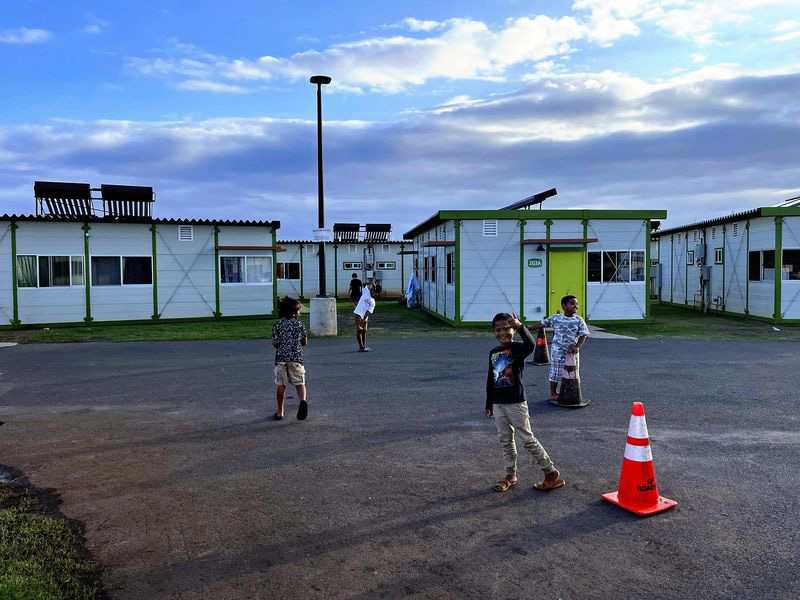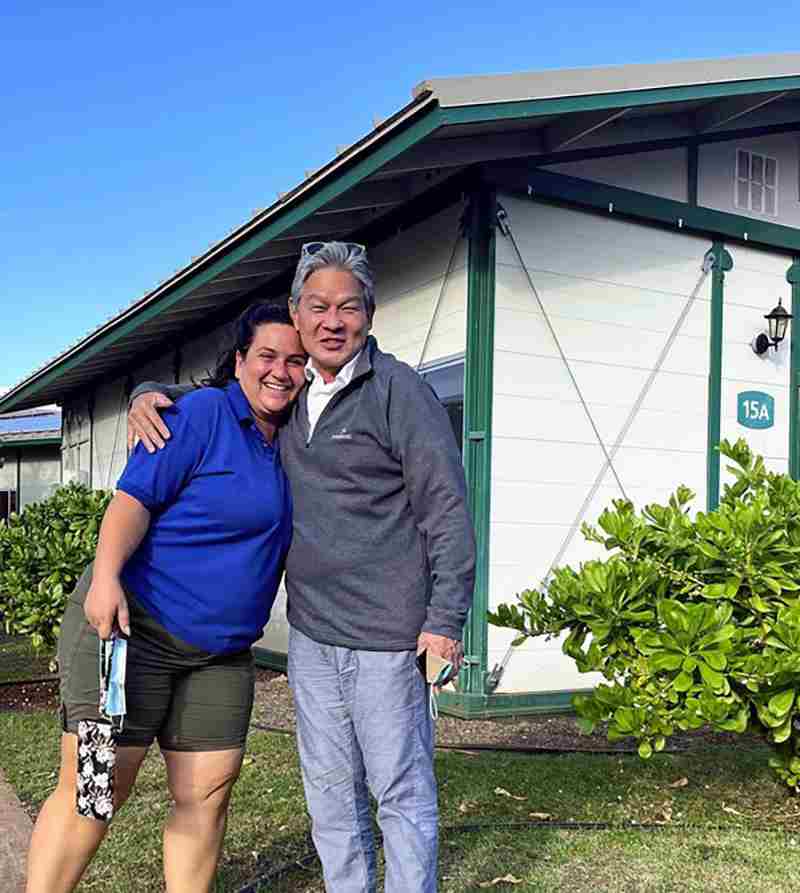
Repurposed emergency housing units that were used after the 2011 Great East Japan Earthquake are seen in Kahauiki Village, a community for families who have experienced homelessness.
18:15 JST, December 31, 2021
HONOLULU — Emergency housing units that were used after the 2011 Great East Japan Earthquake and tsunami have been repurposed to help homeless people in Honolulu, Hawaii, in an initiative launched by a local businessman of Japanese descent who has helped to create a permanent housing solution for people in a U.S. state where homelessness has become a major problem.
Located about nine kilometers west of Waikiki Beach in Honolulu, Kahauiki Village contains emergency housing units that were used in Miyagi and Fukushima prefectures following the 2011 disaster.
Because of the vulnerability of children who experience homelessness, only families with children are housed in the community.
Kaimbrea Vance, 35, who has lived in the village since it was established, said: “We’ve all become family. We watch each other’s kids. If you need sugar someone will give you a cup. We help each other out. It’s been great.”

Duane Kurisu, right, who led the construction of Kahauiki Village, and Kaimbrea Vance, a resident of the village, on Oahu Island in Hawaii on Dec.
The village, which opened in January 2018 with 30 residences, was created through a partnership between the government, civic groups and the private sector.
It was expanded in 2019, and, according to a Hawaiian homeless aid group, the village now has 128 households with 545 residents, about half of whom are children, living in 144 units.
Rent is $725-$900 per month (about ¥83,000-¥103,000), about half to one-third of the market rate in the city, and includes electricity, water and internet.
Each unit is about 30-50 square meters and contains a living room, kitchen, bedroom, toilet and shower. The village also has a daycare center, shop, and post office.
At least one person in each household must be employed, and the community provides assistance and vocational training to help people find jobs as drivers, warehouse workers and bookkeepers, among other professions.
Solar panels with storage batteries are being installed in each unit to keep down electricity costs. In a few years, the village aims to get all its energy from renewable sources.
According to the U.S. government, there are 4,448 homeless people on Oahu Island, which had a population of about 1 million people as of January 2020.
Homeless tents can be seen all over the city.
Duane Kurisu, a 67-year-old businessman who played a major role in building the village, said: “Resolving the issue of homelessness is not about shelter. It’s not about housing. It’s about building community.”
To rebuild their lives, homeless people need social fabric, said Kurisu, who grew up in a sugar plantation town in Hawaii. The third-generation Japanese American businessman has been involved in real estate, media and the dining industry.
From the latter half of the 19th century, many Japanese people emigrated to Hawaii to work on sugar plantations.
Immigrant communities also included people from Southeast Asia and Latin America, and people of different origins lived together helping each other.
After the Great East Japan earthquake, Kurisu raised money for the disaster-stricken areas. When he visited Japan, he was surprised by the durability of the emergency housing units, which were easy to assemble.
He bought some units from a Japanese vendor for a low price and rented a 4.6-hectare plot owned by the state for $1 per year. It cost about $21 million (about ¥2.4 billion) to build the village, most of which was funded by donations.
When the village was being built, critics said the project would not work because homeless people would not be able to form a community together.
Even though some residents have been evicted for using drugs or other infractions, Vance, a single mother who lives with her 4-year-old son, said she might still be homeless without the village.
“It’s a good model for people to replicate across Hawaii and across the world — to use recycled homes from Tohoku,” Kurisu said. “We helped Japan and now Japan is helping Hawaii.”
"World" POPULAR ARTICLE
-

8 Japanese Nationals Stranded on Indonesia’s Sumatra Island
-

U.S. Senate Resolution Backs Japan, Condemns China’s Pressure
-

China to Impose Sanctions on Shigeru Iwasaki, Former Head of Japan’s Self-Defense Forces, Who Serves as Adviser to Taiwan’s Executive Branch
-

South Korea’s Top Court Dismisses Nippon Steel Appeal in Lawsuit over Requisitioned Worker
-

75% of Myanmar People Reject Army’s Political Involvement, According to Survey Conducted by Aid Organization
JN ACCESS RANKING
-

Tokyo Economic Security Forum to Hold Inaugural Meeting Amid Tense Global Environment
-

Keidanren Chairman Yoshinobu Tsutsui Visits Kashiwazaki-Kariwa Nuclear Power Plant; Inspects New Emergency Safety System
-

Imports of Rare Earths from China Facing Delays, May Be Caused by Deterioration of Japan-China Relations
-

University of Tokyo Professor Discusses Japanese Economic Security in Interview Ahead of Forum
-

Japan Pulls out of Vietnam Nuclear Project, Complicating Hanoi’s Power Plans























